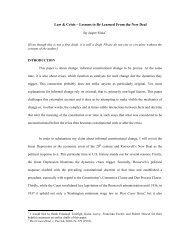An outline of the CCCTB (Common Consolidated Corporate Tax ...
An outline of the CCCTB (Common Consolidated Corporate Tax ...
An outline of the CCCTB (Common Consolidated Corporate Tax ...
Create successful ePaper yourself
Turn your PDF publications into a flip-book with our unique Google optimized e-Paper software.
After considering <strong>the</strong> various possible apportionment methods, <strong>the</strong> services <strong>of</strong> <strong>the</strong><br />
Commission have opted for one based on a distribution formula which uses data<br />
specific to <strong>the</strong> companies, reflecting as far as possible <strong>the</strong> reality <strong>of</strong> <strong>the</strong>ir economic<br />
activity. This is to say that <strong>the</strong> formula is based on <strong>the</strong> microeconomic factors which<br />
have helped to generate <strong>the</strong> tax base, i.e. <strong>the</strong> pr<strong>of</strong>its, <strong>of</strong> each individual taxpayer.<br />
One reason for this choice was that such an approach is already familiar from o<strong>the</strong>r<br />
countries, such as <strong>the</strong> United States and Canada. <strong>An</strong>o<strong>the</strong>r consideration was that<br />
a formula involving three different factors increases <strong>the</strong> chances <strong>of</strong> adherence to<br />
<strong>the</strong> principles referred to above.<br />
In consideration <strong>of</strong> <strong>the</strong> supply/production and demand sides <strong>of</strong> corporate income<br />
generation, <strong>the</strong> following three factors were selected: on <strong>the</strong> supply side, (i) labour,<br />
measured by <strong>the</strong> value <strong>of</strong> <strong>the</strong> payroll and possibly by <strong>the</strong> number <strong>of</strong> employees,<br />
and (ii) capital, measured on <strong>the</strong> basis <strong>of</strong> <strong>the</strong> company’s fixed assets; on <strong>the</strong><br />
demand side, (iii) sales by destination. The weighting <strong>of</strong> <strong>the</strong>se three factors would<br />
be determined in <strong>the</strong> light <strong>of</strong> <strong>the</strong> political debate once <strong>the</strong> impact <strong>of</strong> <strong>the</strong> various<br />
weighting options was known.<br />
The key to this mechanism is that a single formula should apply to all <strong>the</strong> Member<br />
States. In this respect, while variants are evidently required for some specific<br />
sectors, such as financial institutions, <strong>the</strong> formula used for any such sector must<br />
also be uniformly applicable throughout <strong>the</strong> EU. Lastly, <strong>the</strong> sharing mechanism<br />
would apply to all taxable income – not just income from economic activity but also<br />
passive income, such as interest, royalties and dividends to <strong>the</strong> difference <strong>of</strong><br />
United States and Canada where some passive income are directly attributed to a<br />
given jurisdiction.<br />
Assessment <strong>of</strong> <strong>the</strong> selected factors<br />
One <strong>of</strong> <strong>the</strong> advantages <strong>of</strong> a three-factor formula is that it reduces <strong>the</strong> impact <strong>of</strong> any<br />
manipulation <strong>of</strong> one factor or <strong>of</strong> any simplification <strong>of</strong> <strong>the</strong> way in which <strong>the</strong> value <strong>of</strong> a<br />
particular factor is assessed.<br />
For <strong>the</strong> assessment <strong>of</strong> <strong>the</strong> labour factor, it was considered useful to base this on<br />
two elements in order to take account, at least temporarily, <strong>of</strong> differences between<br />
pay levels and <strong>the</strong> underlying productivity levels. These two elements are <strong>the</strong> value<br />
<strong>of</strong> <strong>the</strong> payroll and <strong>the</strong> number <strong>of</strong> employees, which would be equally weighted. The<br />
labour in question is that provided by <strong>the</strong> whole workforce <strong>of</strong> a given entity,<br />
including those agency staff and temporary staff who perform similar tasks to those<br />
<strong>of</strong> <strong>the</strong> regular workforce. Subcontractors’ employees are not included unless <strong>the</strong><br />
subcontractor belongs to <strong>the</strong> same group. The labour cost is represented by <strong>the</strong><br />
amount <strong>of</strong> remuneration, including welfare contributions, benefits in kind, share<br />
options, etc., that was deemed to be deductible when <strong>the</strong> tax base was calculated.<br />
The location <strong>of</strong> labour is, in principle, <strong>the</strong> place <strong>of</strong> work indicated in <strong>the</strong> staff<br />
register, except in cases <strong>of</strong> secondment.<br />
The assessment <strong>of</strong> <strong>the</strong> value <strong>of</strong> fixed assets is not without difficulties. With regard<br />
to <strong>the</strong> definition <strong>of</strong> assets, <strong>the</strong> Commission services suggest that <strong>the</strong>y be confined<br />
24
















